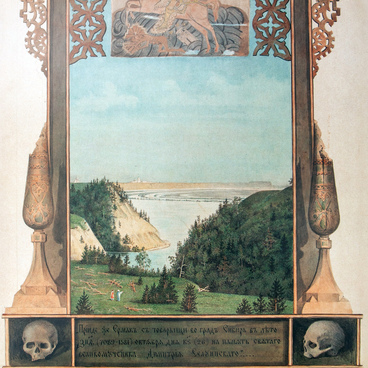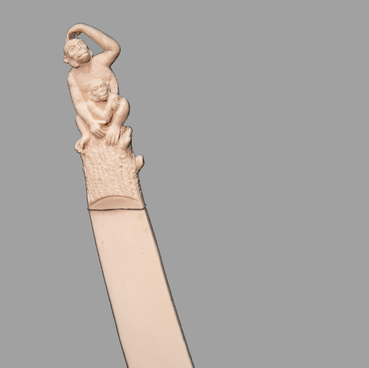The sculpture ‘Butterfly on a Plate’ from the collection of the Tobolsk Provincial Museum was made by Tobolsk bone cutter Nikifor Palyanov. The exact year of creation is unknown. The work dates from the late 19th - early 20th centuries.
To create a miniature sculpture, the author applied the technique of three-dimensional carving and used a white mammoth tusk as the material. Mammoth bone is softer than any other, easier to process, and makes it possible to use various techniques, including the technique of relief carving. On the wings of a butterfly, the master made a relief image of a pattern of veins. This work required high technical skill. Palyanov fixed the figure itself on a rectangular contrasting stand made of brown bone that imitates wood.
The artist Nikifor Palyanov studied bone-cutting skills in the First Private Workshop, which was opened in Tobolsk in 1874 by the Oveshkov family. It was believed that the best masters of the pre-revolutionary bone-cutting Tobolsk craft were trained here by the artist Ivan Oveshkov. Working in the workshop significantly influenced the formation of Nikifor Palyanov’s taste. He is characterized by a clear artistic style and precise elaboration of all the details of the sculpture.
Palyanov continued to improve his skills in the “Exemplary Siberian Workshop” of Yu.I. Melgunova who came to Tobolsk from St. Petersburg in 1893. Melgunova set up her business on a large scale. She quickly established artistic production of bone sculptures and established strong ties with St. Petersburg, Moscow, Kiev, Riga, Nizhny Novgorod, Tyumen, and Kurgan.
In 1902, the Yearbook of the Tobolsk Provincial Museum wrote:
To create a miniature sculpture, the author applied the technique of three-dimensional carving and used a white mammoth tusk as the material. Mammoth bone is softer than any other, easier to process, and makes it possible to use various techniques, including the technique of relief carving. On the wings of a butterfly, the master made a relief image of a pattern of veins. This work required high technical skill. Palyanov fixed the figure itself on a rectangular contrasting stand made of brown bone that imitates wood.
The artist Nikifor Palyanov studied bone-cutting skills in the First Private Workshop, which was opened in Tobolsk in 1874 by the Oveshkov family. It was believed that the best masters of the pre-revolutionary bone-cutting Tobolsk craft were trained here by the artist Ivan Oveshkov. Working in the workshop significantly influenced the formation of Nikifor Palyanov’s taste. He is characterized by a clear artistic style and precise elaboration of all the details of the sculpture.
Palyanov continued to improve his skills in the “Exemplary Siberian Workshop” of Yu.I. Melgunova who came to Tobolsk from St. Petersburg in 1893. Melgunova set up her business on a large scale. She quickly established artistic production of bone sculptures and established strong ties with St. Petersburg, Moscow, Kiev, Riga, Nizhny Novgorod, Tyumen, and Kurgan.
In 1902, the Yearbook of the Tobolsk Provincial Museum wrote:



